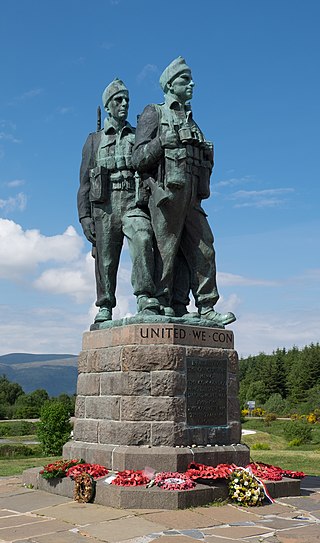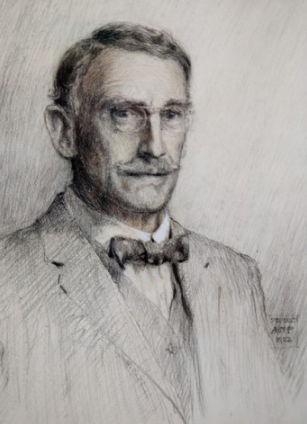
Luss is a village in Argyll and Bute, Scotland, on the west bank of Loch Lomond. The village is within the Loch Lomond and The Trossachs National Park.

A mercat cross is the Scots name for the market cross found frequently in Scottish cities, towns and villages where historically the right to hold a regular market or fair was granted by the monarch, a bishop or a baron. It therefore served a secular purpose as a symbol of authority, and was an indication of a burgh's relative prosperity. Historically, the term dates from the period before 1707, when the Kingdom of Scotland was an independent state, but it has been applied loosely to later structures built in the traditional architectural style of crosses or structures fulfilling the function of marking a settlement's focal point. Historical documents often refer simply to "the cross" of whichever town or village is mentioned. Today, there are around 126 known examples of extant crosses in Scotland, though the number rises if later imitations are added.

Clan Colquhoun is a Highland Scottish clan.

The Battle of Glen Fruin was a Scottish clan battle fought on 7 February 1603 between the Clan Gregor and its allies on one side, and the Clan Colquhoun and its allies on the other. The Clan Gregor and Clan Colquhoun were at feud due to the MacGregors carrying out raids on the Colquhoun's lands. The Colquhouns gained royal support and raised an army against the MacGregors. However, during the subsequent battle of Glen Fruin, the Colquhouns were comprehensively defeated. Glen Fruin is in the Loch Lomond area, in the county of Dunbartonshire, Scotland. In the aftermath of the battle royal policy punished the MacGregors for 150 years.
Sir Ivar Iain Colquhoun, 8th Baronet, JP, DL was a British noble.

Inchmoan is an island in Loch Lomond, Scotland.

Scottish war memorials are found in all communities in Scotland. They are found on most main streets and most churches in Scotland. Many commemorate the sacrifice of the First World War but there are many others to wars before and since 1914–1918.

The Commando Memorial is a Category A listed monument in Lochaber, Scotland, dedicated to the men of the original British Commando Forces raised during World War II. Situated around a mile from Spean Bridge, it overlooks the training areas of the Commando Training Depot established in 1942 at Achnacarry Castle. Unveiled in 1952 by the Queen Mother, it is one of Scotland's best-known monuments, both as a war memorial and as a tourist attraction offering views of Ben Nevis and Aonach Mòr.
Helensburgh Cemetery is an operational burial ground, dating from the mid 19th century, on the Old Luss Road in Helensburgh, Argyll, Scotland. Together with its boundary walls, lodge, gatepiers and gates it is designated as a Category B listed building by Historic Scotland.

Alexandra "Sasha" Alexeyevna Luss is a Russian model and actress best known for portraying Anna Poliatova in the 2019 film Anna.
Before the Acts of Union 1707, the barons of the shire of Dumbarton elected commissioners to represent them in the unicameral Parliament of Scotland and in the Convention of the Estates.

Doune Hill is a peak in the foothills of the Grampian Mountains of Scotland. It is located near the village of Luss in Argyll and Bute, west of Loch Lomond.

Pier Road is a street in Luss, Argyll and Bute, Scotland. Located on Loch Lomond's western shore, the road, which is on an east–west alignment, consists of around twenty buildings, many of which are listed cottages dating from the 19th century.

Elmbank is a building in Luss, Argyll and Bute, Scotland. It is a Category C listed building, dating to the early 19th century.

Thistle Cottage is a building in Luss, Argyll and Bute, Scotland. A Category C listed cottage dating to the late 19th century, it overlooks the western shore of Loch Lomond to the north of Luss Pier.

Shore Cottage is a building in Luss, Argyll and Bute, Scotland. A Category C listed cottage dating from the early to mid-19th century, it overlooks the western shore of Loch Lomond to the south of Luss village. It is the only building on the southern stretch of the shore path; between the cottage and the village are the back gardens of the properties on Church Road to the west.

Sunnyside is a building in Luss, Argyll and Bute, Scotland. It is a Category B listed structure dating to the mid 19th century.
Luss General Store is a building in Luss, Argyll and Bute, Scotland. It is a Category C listed structure dating to the mid-19th century. It was formerly the village post office.
Alderdale is a building in Luss, Argyll and Bute, Scotland. It is a Category C listed structure dating from the early-to-mid 19th century.

Alexander Nisbet Paterson ARIBA PRIAS (1862–1947) was a Scottish architect, mainly working in the Arts and Crafts style. He was president of the Royal Institute of Architects in Scotland (RIAS).
















